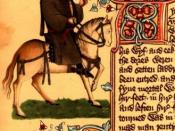Canterbury Tales Compared to Dante's Inferno This study will explore the themes of innocence and guilt in the "Hell" section from Dante's Divine Comedy and Chaucer's Canterbury Tales. The study will focus on the uses each author makes of urban and more natural settings to convey messages about innocence and guilt. While both Dante and Chaucer make use of this motif in making their thematic points, a great difference exists between them. Chaucer's primary purpose is to present a humorous and compassionate portrayal of human existence including innocence and guilt, or goodness and evil while Dante's essential purpose is moral and instructional.
Chaucer uses urban and country references in his portrayal of the human condition as a means of drawing a contrast between the goodness and evil of humankind. Again, we must keep in mind that Chaucer uses setting to reveal truths about humanity from an empathic perspective.
He does not want to judge, but to entertain and perhaps inspire compassion for self and others as flawed beings. Therefore, when he uses natural or urban settings, he is not saying that human beings are good when they are in Canterbury, and evil when they are out in the countryside. At the same time, that is precisely the apparent truth of the matter. As Chaucer paints the picture of human desire and passion, there is an intimate connection between that passion (which can lead to a loss of innocence) and a natural setting: When April with his showers sweet with fruit The drought of March has pierced unto the root And bathed each vein with liquor that has power To generate therein and sire the flower; When Zephyr also has, with his sweet breath, Quickened again, in every holt and heath, The tender shoots and buds . .


